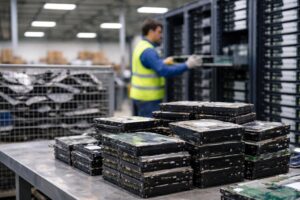The cold chain logistics sector is facing a critical moment. Temperature-sensitive products are in high demand worldwide, and the sector is under pressure to lessen its environmental impact. In addition, worries about climate change are growing, and laws are becoming stricter. This is creating a complex landscape of challenges and opportunities.
Navigating sustainable cold chain logistics can be challenging. Yet, for companies willing to adapt and innovate, exciting possibilities emerge. This article explores key challenges in sustainable cold chain management and delves into solutions shaping its future. So, let’s dive in.
The Environmental Imperative in Cold Chain Logistics
An important environmental consequence of the cold chain industry is acknowledged. Its energy-intensive processes significantly increase emissions of greenhouse gases. It includes transportation and refrigeration This issue is crucial for the industry, but it also offers opportunities for long-term leadership and innovation.
Energy Consumption and Emissions
Cold chain logistics depend on constant temperature control, which leads to high energy use and substantial emissions. Furthermore, refrigerated warehouses and transportation units need continuous power, often sourced from fossil fuels. So, this not only raises operating costs but also contributes to climate change. The industry struggles to find solutions that reduce emissions and cut energy use while remaining competitive. Still, encouraging answers are beginning to surface.
One way to address the issue is by using renewable energy sources. More and more firms are putting up solar or wind power systems on their warehouse rooftops. Even biomass energy is being considered by some. So, over time, these substitutes can drastically lower energy expenditures and emissions. Equipment that uses less energy is also another essential remedy. Warehouses using LED lighting use less power, and modern refrigeration systems require less energy. Moreover, enhancing the insulation can also have a significant impact. Businesses that purchase these technologies frequently get a rapid payback in the form of less energy costs.
Refrigerant Management
Strong greenhouse gases called hydrofluorocarbons (HFCs) are still used in a lot of cold chain systems. So, cutting back on their usage presents a chance as well as a difficulty. Due to this, Eco-friendly refrigerants are becoming more and more common. Natural refrigerants with no effect on the environment include ammonia and CO2.
Furthermore, a company’s environmental impact can be significantly decreased by converting to these alternatives. Making the change, though, may be difficult. In addition to the frequent need for new equipment and employee training, safety issues arise. Despite these challenges in sustainable cold chain management, businesses that swiftly adapt can obtain a competitive edge.
Food Waste Reduction
Food waste can be greatly increased by cold chain inefficiencies, which are essential for maintaining the freshness of perishable items. This issue affects both the ecology and the economy. Moreover, food waste is a symbol of lost income and resource waste.
Solving this issue presents a big opportunity. Waste can be significantly decreased with enhanced handling practices and temperature monitoring. Furthermore, modern technology is being used by certain businesses. This is to forecast demand, optimize inventory levels, and cut down on waste and excess.
Another good option is creative packaging. Produce can be kept fresher longer using edible coatings and longer-lasting packaging in a changed climate. These developments not only reduce waste but also provide cold chain vendors access to new markets.
Technological Innovations For Sustainable Cold Chain Logistics
Technology is transforming the cold chain industry by offering solutions to several environmental problems. So, let’s see how the industry is undergoing a change owing to innovations:
Efficient Refrigeration Systems
Traditional refrigeration systems are recognized for consuming enormous amounts of electricity. Nevertheless, new technologies are altering this situation. Some effective substitutes for traditional systems are thermoelectric cooling and magnetic refrigeration. Additionally, they have little effect on the environment.
The challenging issue is scaling these technologies for industrial use for sustainable cold chain logistics. Companies that engage in this area of research and development might reap significant rewards. Even the systems that are in place now are being upgraded. Furthermore, variable-speed compressors reduce energy use by adapting to demand. Moreover, the system’s defrost algorithms only function when required. So, these small changes might add up to big savings in the long run.
IoT and Big Data Analytics
The IoT is revolutionizing cold chain management. Smart sensors are providing real-time monitoring of temperature, humidity, and other parameters. As a result, this data allows for scheduled maintenance and accurate management through the use of analytics tools. These gadgets can anticipate problems and automatically optimize energy use. They even help with the planning of chilled transit routes. So, there is a great chance to gain efficiency.
Implementing these technologies will require a large investment of time and money in expertise. However, companies that execute it well might save a significant amount of money, improve the caliber of their output, and reduce waste. So, as the technology becomes more accessible, it will most likely become standard procedure in the sector.
Alternative Fuel Vehicles
In the cold chain, transportation is a significant source of emissions. So, electric and hydrogen-powered vehicles provide an option that can save operating expenses over time and result in lower emissions.
Furthermore, infrastructure is still a problem for sustainable cold chain logistics, and it takes a large initial investment. While hydrogen fuelling facilities are still few, electric vehicle charging stations are becoming more and more common. So, the tendency is evident despite these obstacles. Moreover, a number of companies are presently replacing their fleets thanks to government incentives & technology advancements.
Operational Strategies for Sustainable Cold Chain Logistics
For sustainable cold chain logistics, operational methods are equally as critical as technology. Furthermore, these approaches focus on optimizing processes and using resources more efficiently.
Route Optimization and Load Consolidation
Efficient route planning can significantly cut fuel use. Furthermore, load consolidation reduces the number of trips needed. So, both strategies lower emissions and costs. Moreover, advanced algorithms and AI-powered tools are making this optimization more sophisticated.
These systems consider multiple factors, including traffic patterns and weather. The result is more efficient logistics operations. Additionally, implementing these systems takes effort and often requires changes to established processes. However, the payoff can be substantial, with reduced fuel costs and improved delivery times.
Sustainable Packaging Solutions
Packaging plays a big role in cold chain efficiency. Better insulation means less energy for cooling. New materials are making this possible, with some options being biodegradable or recyclable. As a result, this helps address the issue of waste in the cold chain.
Furthermore, vacuum-insulated panels provide excellent insulation with minimal thickness. Moreover, phase change materials help maintain stable temperatures. So, the challenge is balancing performance with cost for sustainable cold chain logistics. Some advanced materials are expensive, but prices are falling as production scales up.
Collaborative Networks and Shared Infrastructure
Working together can lead to more efficient resource use. Furthermore, shared warehousing saves energy, while coordinated transportation reduces empty miles. So, these strategies can cut costs and emissions.
Setting up these networks isn’t easy. It requires trust between competitors and sophisticated coordination systems. Nevertheless, the benefits can be significant. Companies can access new markets and reduce their carbon footprint. Some regions are setting up cold chain hubs – centralized facilities serving multiple companies. So, for smaller players, this can be a game-changer.
Sustainable Cold Chains: Regulatory Landscape and Compliance
The laws pertaining to sustainability are changing quickly. Success in the field depends on your ability to comprehend and follow these guidelines.
Emissions Reporting and Reduction Targets
Nowadays, a lot of states have reporting requirements for emissions and are establishing logistics-related reduction goals. To achieve these objectives, businesses must have strong tracking systems and plans. Although some view this as a burden, innovation is being spurred by it for sustainable cold chain logistics.
Businesses are reducing their emissions in novel ways and gaining efficiencies that they would not have otherwise noticed. Furthermore, a strong showing of these measures can serve as a selling factor. Moreover, consumers want to collaborate with sustainable partners and are becoming more environmentally concerned.
Energy Efficiency Standards
Governments are imposing more stringent requirements on facilities and equipment. So, investing in improvements or new equipment is frequently necessary to meet these criteria. Over time, though, these expenditures frequently pay themselves in the form of cheaper operational expenses.
Certain firms are surpassing compliance and establishing their elevated benchmarks. A higher market position and more efficiency are possible outcomes of this proactive strategy. Additionally, it protects companies against potential increases in energy costs and regulatory tightening.
Incentives for Sustainable Practices
A number of countries promote green behavior through tax incentives for renewables and energy efficiency subsidies. Although navigating these programs might be challenging, there can be significant advantages.
To find and obtain these incentives, several businesses are setting up specialized teams. It’s starting to play a major role in industrial finance planning. Additionally, these initiatives or opportunities in eco-friendly cold chain solutions are spurring innovation, motivating businesses to experiment with new technology, and quickening the shift to more environmentally friendly practices for sustainable cold chain logistics.
To Sum Up
The transition towards sustainable cold chain logistics is complex but full of opportunities. As the industry faces pressure to reduce environmental impact while meeting growing demand, companies embracing change can gain a competitive edge. Innovative technologies and operational strategies are transforming the sector while evolving regulations continue to push towards greater sustainability.
For professionals navigating these challenges, the Net-Zero Supply Chain Summit offers valuable insights. This event, scheduled for September 12-13, 2024, in Amsterdam, Netherlands brings together industry leaders to discuss cutting-edge solutions in sustainable cold chain logistics and more. It presents an opportunity to shape the future of the supply chain. So, attendees will have the chance to learn, network, and discover solutions that can drive business forward. Register now!




